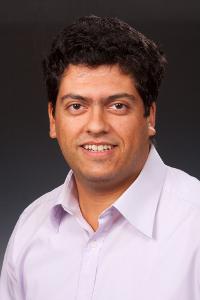The University's Center for Autonomic Computing developed a wireless sensor project that detects human motion and can further medical research.
The sensors, which are small devices that attach to the body, contain accelerometers and gyroscopes that measure movement and can tell what action a person is doing, said Alex Weiner, a School of Engineering junior who is fine-tuning the algorithm of the sensors.
Dario Pompili, assistant professor in the Department of Electrical and Computer Engineering, said the project could help behavioral scientist Theodore Walls from the University of Rhode Island with his research into smoking habits.
Pompili said smokers may not give an accurate self-report on their smoking habits, so doctors can rely on the sensors to give a better report, which can ultimately result in better care for the patient.
"There is a lot of bias in self-reporting. Maybe the smoker smokes more because of the stress of the self-reporting, or he reports a lower amount," he said.
A smoker would need two wireless sensors — one on the wrist and the other on the shoulder — for a computer to understand when and for how long they were smoking, Pompili said.
"The accelerometer captures motion on all three axes, and the gyroscope measures angular velocity," he said.
The sensor project is an extension of former graduate student John Paul Varkey's research in monitoring smoker's actions, Weiner said. The sensor can detect the difference between an arm in the resting position and one raised to the mouth while smoking.
The computer is programmed with a supervised learning algorithm, in which the computer begins to recognize inputs it is fed, Weiner said.
"You tell the machine, ‘This is what smoking looks like,' three or four times [and] next time it should recognize it," he said.
Weiner said the sensor has been successful in recognizing different motions and distinguishing actions like smoking from walking.
"I'd say the success rate is 98 percent for recognizing different actions but only moderately successful in recognizing similar motions," he said.
The sensor recognizes actions with a larger difference in movement easier than actions that are similar, Weiner said.
"Something like brushing one's teeth is a somewhat similar motion to smoking, and the computer would have a hard time distinguishing that," he said.
Although the accelerometer and gyroscopes measure the duration one is smoking for, it does not measure the reasons for smoking, Pompili said.
"We need to understand behavior, we need to [know] when and where you smoke, or if you smoke because you are with someone," he said.
The sensors can measure other aspects besides movement, said Hariharasudhan Viswanathan, a School of Engineering graduate student who contributes to the project.
"We have sensors to measure temperature and humidity, and we also have EKG or ECG sensors that can be used to measure heart rates," he said.
In the future, the project will include a smoke sensor, Viswanathan said.
"Right now we only measure how long the person smokes, but with this we can see if he takes a lot of puffs, and see how much intake there is," he said.
Viswanathan hopes to create an e-doctor application, in which doctors could provide remote health care to patients.
"Let's say you need an EKG. You place three sensor nodes on the body and then the results can go to your doctor. It's cheap and efficient," he said.
Weiner said the project could assist athletes, help doctors in third world countries and monitor the elderly.
Pompili also suggested that sensors could be used in the military for measuring soldiers' vital signs on the battlefield.
"It would be a great application for the army," he said. "Through an ad-hoc wireless network, you could have vital information of the soldiers."
Pompili said the soldiers could wear a smart suit with the sensors on the field, which would feed information back to the base and provide information that was previously unavailable.
"You could read the vitals and predict fainting due to stress and many other problems," he said. "Plus it's a non-invasive way to obtain this information."
This article was published by The Daily Targum

